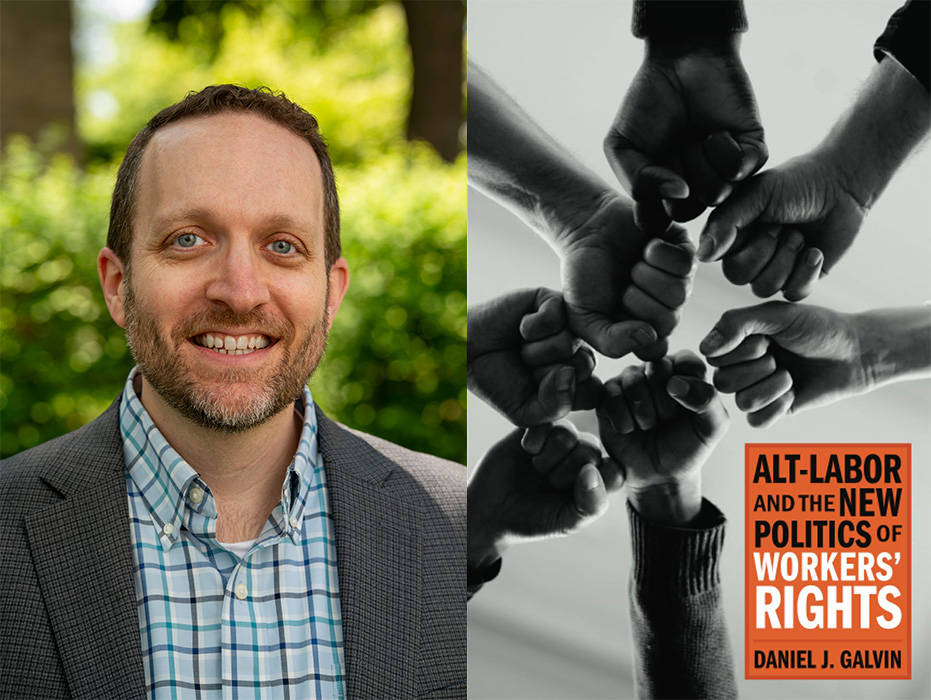The New Politics of Alt-Labor
Daniel Galvin’s new book and research lab focus on low-wage workers’ rights
Get all our news
It was surprising and interesting to me that a lot of these laws were being pushed by small community-based nonprofit groups that were not unions, but that still organized workers.”
Daniel Galvin
IPR political scientist

In 2016, the progressive community organization Living United for Change in Arizona (LUCHA) successfully pushed for a higher minimum wage and the right to paid sick leave in Arizona through a ballot measure. During the 2020 election, the group registered 47,000 new voters—playing a role in President Biden’s victory in the battleground state.
LUCHA’s advocacy demonstrates some of the new ways low-wage workers are engaging in politics outside of unions.
In his new book Alt-Labor and the New Politics of Workers’ Rights (Russell Sage Foundation, 2024), IPR political scientist Daniel Galvin traces the rise of alt-labor organizations, nonprofits that organize and support low-wage workers. Low-wage workers make up roughly 44% of the U.S. workforce, earn $10 an hour on average, and include a disproportionate number of Black and Latinx workers, immigrants, and women.
Galvin also recently launched the Workplace Justice Lab at Northwestern, a sister organization of the Workplace Justice Lab at Rutgers University. The lab supports state and local agencies in enforcing labor standards and collaborates with alt-labor groups.
Tracking the Rise of Alt-Labor Groups
Galvin grew interested in alt-labor groups after studying wage theft and state laws that protect workers from losing their earnings.
“It was surprising and interesting to me that a lot of these laws were being pushed by small community-based nonprofit groups that were not unions, but that still organized workers,” he said.
He explains in his book that as New Deal-era labor laws failed to keep pace with a changing economy, states began to enact employment laws to create stronger worker protections. Those rights and protections, however, were scattered across different states, difficult to access, and didn’t protect the most vulnerable workers from abuse and exploitation.
Starting in the 1970s, deregulation, the decline of unions, and the changing composition of industries altered low-wage work and drew millions of new immigrants to the U.S. The growing problems low-wage workers faced—poor job quality, rampant exploitation, and a lack of adequate protections—set the stage for alt-labor groups to emerge, Galvin said. In the 1990s, there were only a handful of alt-labor groups. Today there are roughly 250 to 300.
Alt-labor groups traditionally provide services and organize direct actions to expose employer wrongdoing through protests and negative media coverage.
“But over time, the groups learned that both services and direct action campaigns are inherently reactive and backward-looking,” Galvin explains. “The exploitation or abuse has already occurred.”
To protect against future workplace abuse, alt-labor groups turned their attention to passing public policies at the local level. This includes laws to combat wage theft, bolster health and safety rules, raise the minimum wage, fight discrimination, and introducing new protections like paid sick leave, fair workweek, and anti-retaliation. In states hostile to pro-worker legislation, many alt-labor groups have established 501(c)4 “social welfare” organizations, enabling them to engage more directly in electoral politics.
Galvin says alt-labor groups try “to alter the contours of their political environment” through direct political activity such as voter registration campaigns, influencing who is selected for office, and pushing new issues onto the agenda.
Given how small and poor the groups are and how marginalized their workers are in the political arena, he says, “it is amazing how far they have come in their efforts to shift the balance of power in their communities.”
Supporting Labor Standards Enforcement and Alt-Labor Groups
The new Workplace Justice Lab grew out of a multi-year collaboration between Galvin and his colleagues at Rutgers examining wage theft and encouraging state and local agencies to adopt more strategic enforcement practices. The team is currently made up of academic researchers, lawyers, former government staff, and labor organizers.
Along with conducting research, the lab helps state and local agencies improve their enforcement of labor standards through a program called “Beyond the Bill.” They have trained and worked with government labor departments in several states and localities, including Illinois, New Jersey, Los Angeles County, and Minneapolis. New Jersey’s labor department recently overhauled its enforcement procedures as a result of studies and trainings offered by the lab.
They also collaborate with community-based workers’ organizations. Through their program “Build the Base,” they teach alt-labor groups about cutting-edge organizational models used by successful worker centers to help grow their memberships and establish more democratic leadership structures.
Galvin says alt-labor organizations—often small and underfunded—face serious challenges because of their precarious structures and finances. Unlike labor unions, alt-labor groups don’t usually require membership dues and often rely on private philanthropic support.
“That creates a question of accountability: Who do the groups’ leaders answer to—their members or their funders?” Galvin said. “But also raises questions of durability and sustainability.”
Despite their small size, he says that alt-labor groups have been surprisingly successful at exposing the problems low-wage workers face and highlighting the disconnect between the rights we have as public citizens and the far more limited rights we have in the workplace.
“Most people spend the majority of their time either sleeping or at work,” Galvin said. “So, the rights people have at work are critical.”
Daniel Galvin is professor of political science, IPR fellow, and Director of the Workplace Justice Lab@NU.
Photo credit: Image of Daniel Galvin by Rob Hart
Published: July 19, 2024.


